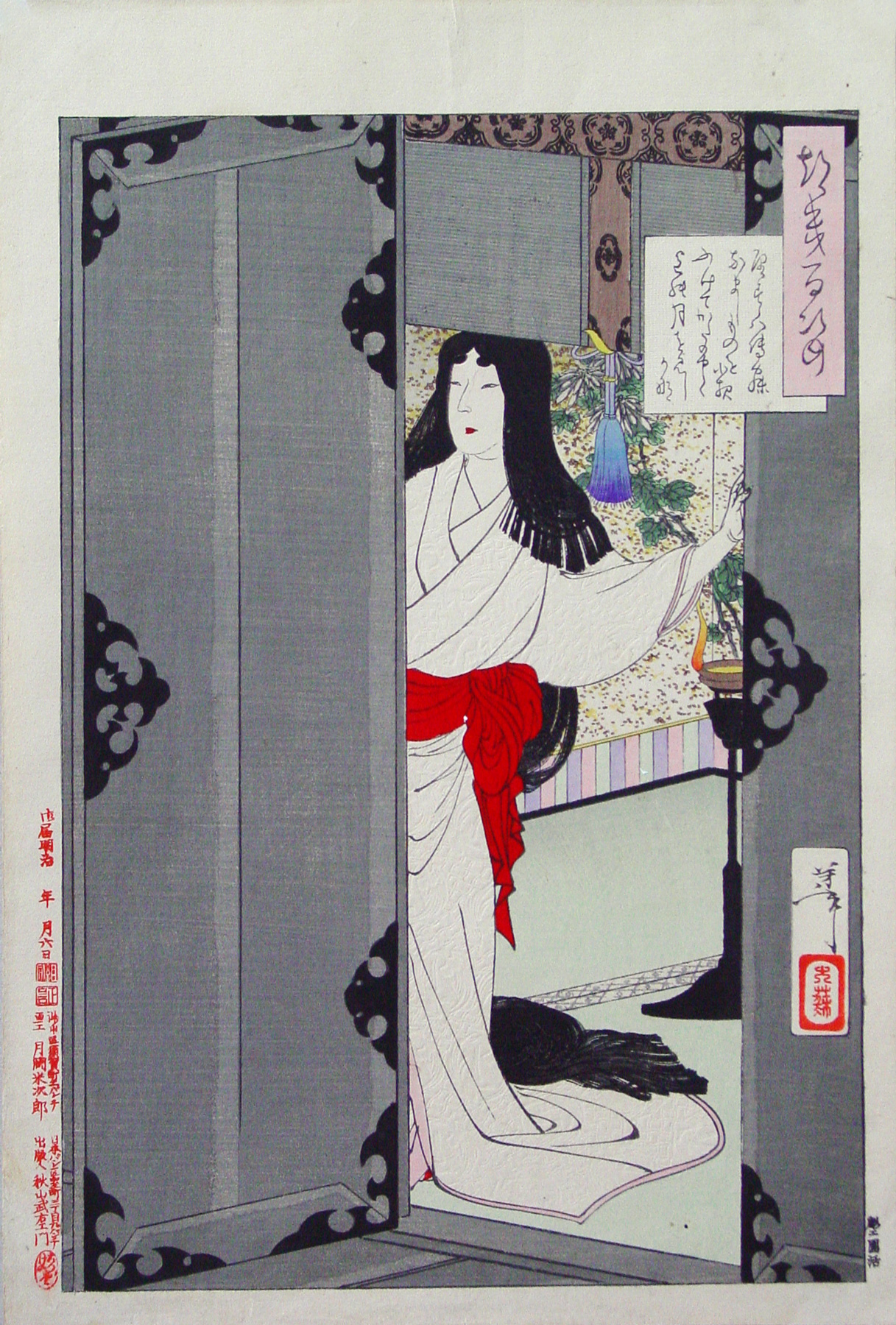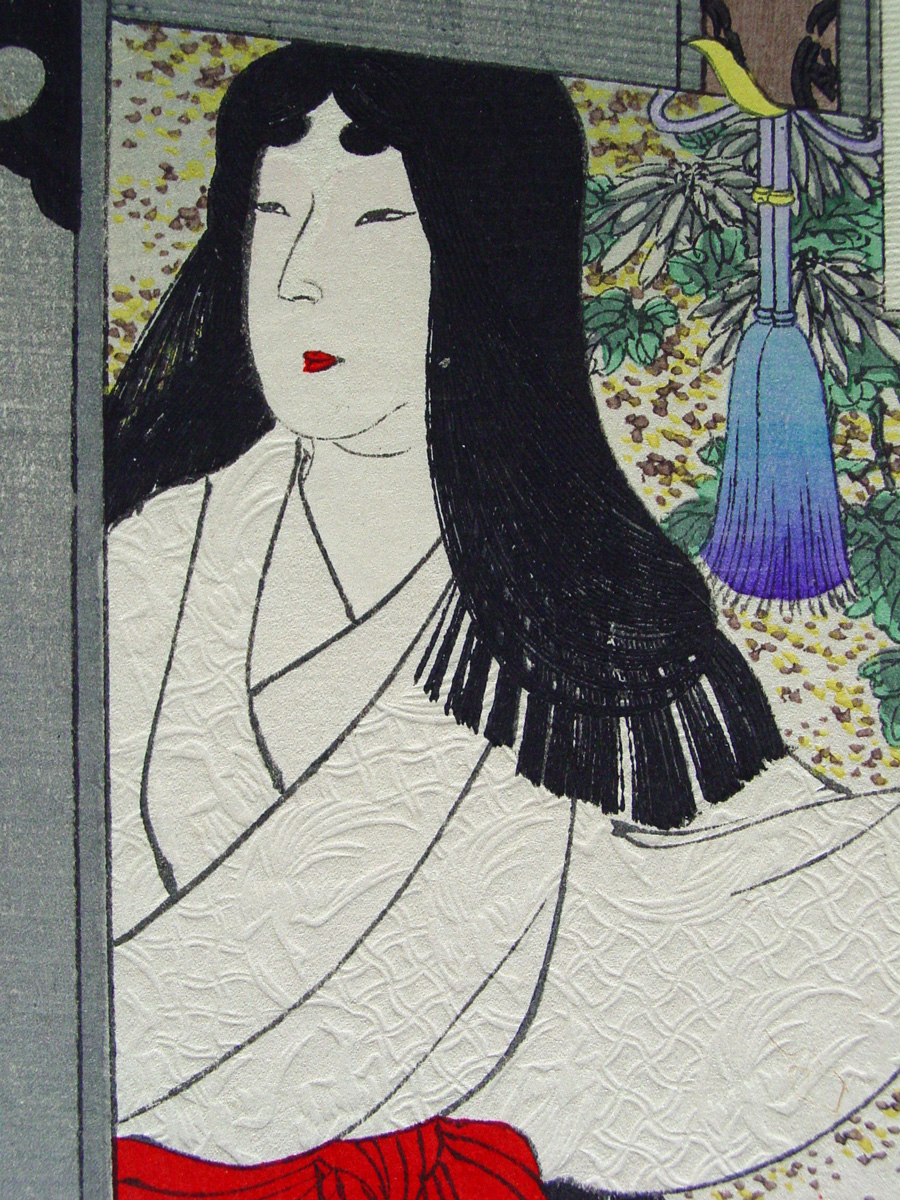About This Print
Source: Museum of International Folk Art http://www.internationalfolkart.org/exhibitions/past/moonweb/section1/035.htm
An early, if not first, state of this print, with heavy embossing of the white robe.
The Story Depicted in the Print as Told by John Stevenson
Source: Yoshitoshi's One Hundred Aspects of the Moon, John Stevenson, Hotei Publishing, Netherlands 2001
44.
I wish I had gone to bed immediately
But now the night has passed
And I watch the moon descendv
yasurawade
nenamashi mono o
sayo fukete
katabuku made no
tsuki o mishi kana
Akazome Emon, who wrote this poem, lived from about 956 to about 1041, making her a contemporary of the lady writers Sei Shōnagon and Murasaki Shikibu during a particularly brilliant period at the Heian court. For a time Akazome Emon and Lady Murasaki served one of the emperor’s consorts together.
But now the night has passed
And I watch the moon descendv
yasurawade
nenamashi mono o
sayo fukete
katabuku made no
tsuki o mishi kana
Akazome Emon, who wrote this poem, lived from about 956 to about 1041, making her a contemporary of the lady writers Sei Shōnagon and Murasaki Shikibu during a particularly brilliant period at the Heian court. For a time Akazome Emon and Lady Murasaki served one of the emperor’s consorts together.
Akazome Emon later entered the household of Fujiwara no Michinaga, the most important political figure of the time. When Michinaga died in 1027, Akazome wrote a celebrated history of the Fujiwara, who were the dominant political family for several centuries. The Fujiwara’s position was strengthened by a policy of intermarriage with the imperial family. Michinaga, who virtually governed Japan for thirty years, married three of his daughters to three successive emperors.
The print illustrates a poem that Akazome Emon has written at the end of a long, sleepless night. The poem implies that peace of mind has been denied her because she has been waiting for her lover to visit. She would have gone to sleep if she had known that he would not come, but instead she has stayed up all night, hoping. Now she stands disappointed by the entrance to her room, gazing at the setting moon.
Yoshitoshi often created an aura of intimacy in his prints of women by showing them somewhat disheveled, but not in this design. Akazome is portrayed as a dignified and self-possessed noblewoman. Yet the scene is not entirely chaste, since the prominence given to her red sash suggests her absent lover.
Akazome’s hair has been combed out and hangs almost impossibly long in the Heian style of ideal beauty. Her eyebrows have been shaved and false “moth eyebrows” painted on her forehead, a distinctive fashion of the Heian aristocracy used by both men and women. A woman’s soft eyebrows were compared to the feathery antennae of the silk moth in a Chinese poem as far back as 750 B.C. In a flowery extension of the image, moth eyebrows were sometimes likened to a crescent moon appearing over mountains.
The gold-speckled screen in the background gives an aura of luxury to the print. The chrysanthemum on the screen suggests that the season is mid autumn; the flower is painted in a detailed Meiji style, an anachronism. Well-considered touches of color, such as the yellow hook supporting the bamboo blind and the tiny patch of red undergarment at Akazome’s feet, enliven the design. In early impressions the robes of the poetess have been heavily embossed, which no reproduction can adequately convey.
Only the day, “six,” is given in the space left for the printing date in the left margin. Because the word otodoke is include in the censorship details, we know that the print must have been made in 1887 or earlier, as the reporting requirements changed during that year. The style of Yoshitoshi’s signature indicates a printing date of 1887 or later. Different designs of the Moon Series were often published in small batches – two other designs were issued on the sixth day of the first month of 1887, and this design may well have been issued at the same time.
Image from Publisher's Bound Album (Issued shortly after Yoshitoshi's death)
About the Series "One Hundred Aspects of the Moon"For details about this series which consists of one hundred prints with the moon as a unifying motif, see the article on this site Yoshitoshi, One Hundred Aspects of the Moon.
Print Details
| IHL Catalog | #52 |
| Title | Akazome Emon (The Poetess Awaiting Her Lover) (Akazomemon 赤染衛門) |
| Series | One Hundred Aspects of the Moon (Tsuki hyaku sugata つきの百姿) |
| John Stevens Reference No.* | 44 |
| Artist | Tsukioka Yoshitoshi (1839-1892) |
| Signature | Yoshitoshi 芳年 |
| Seal | Taiso 大蘇 |
| Date | January 6, 1887 (note Stevens shows a question mark next to this date. A further explanation is provided above in the text.) |
| Edition | A single sheet issue, not bound into an album. An early state of the print. |
| Publisher | Akiyama Buemon (秋山武右エ門) [Marks: seal 26-132; pub. ref. 005] |
| Carver | Enkatsu Noguchi |
| Impression | excellent |
| Colors | excellent |
| Condition | excellent - minor toning and soiling; untrimmed; not backed. |
| Genre | ukiyo-e |
| Miscellaneous | |
| Format | oban |
| H x W Paper | 14 5/8 x 9 7/8 in. (37.1 x 25.1 cm) |
| H x W Image | 12 7/8 x 8 7/8 in. (32.7 x 22.5 cm) |
| Collections This Print | Smithsonian National Museum of Asian Art S2003.8.3053; New York Public Library Humanities and Social Sciences Library / Spencer Collection; Yale University Art Gallery 2011.143.1.44; The Tsubouchi Memorial Theatre Museum of Waseda University 201-4483; Ritsumeikan University ARC NDL-541-00-062 |
| Reference Literature | * Yoshitoshi’s One Hundred Aspects of the Moon, John Stevenson, Hotei Publishing, Netherlands 2001, pl. 44. |




